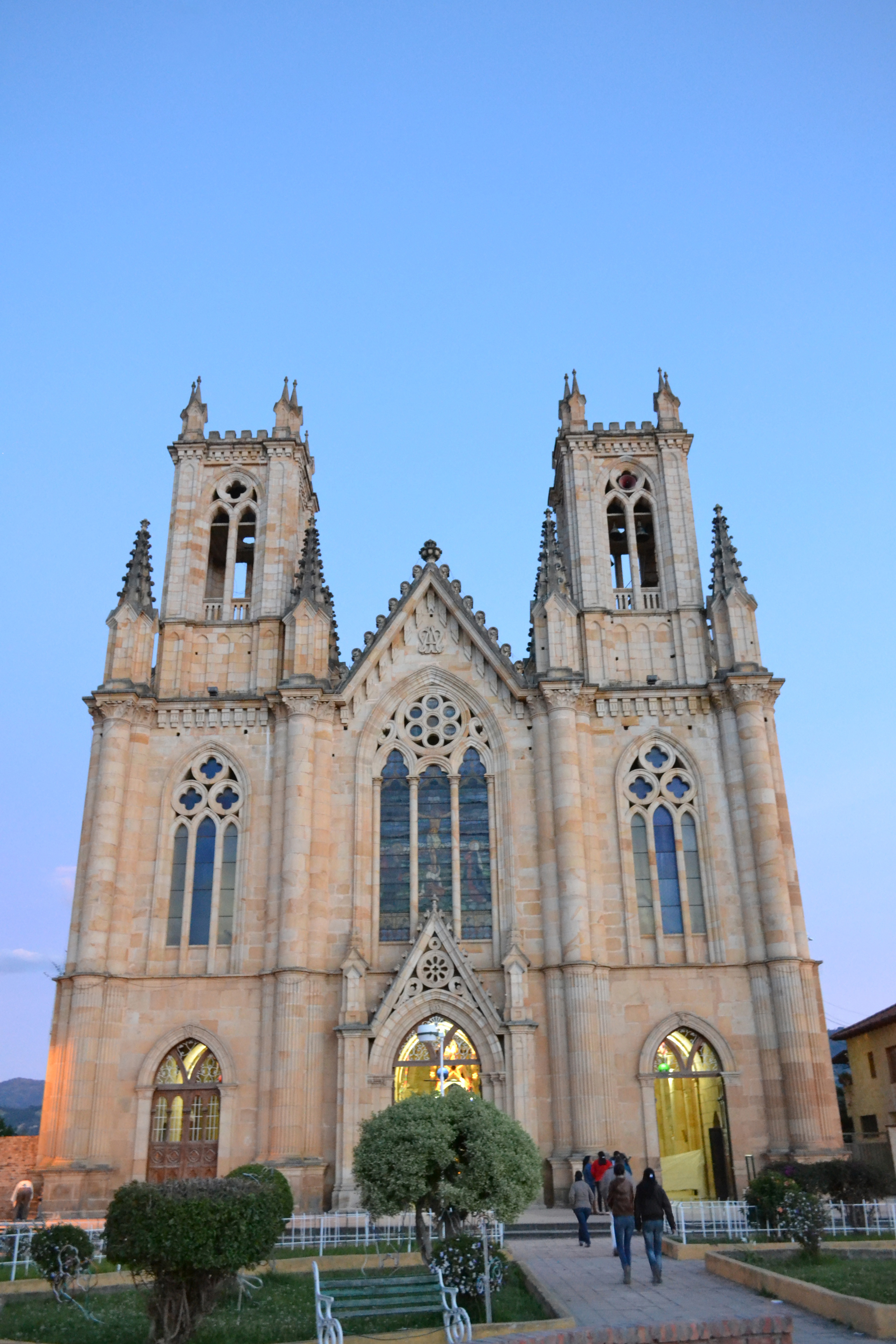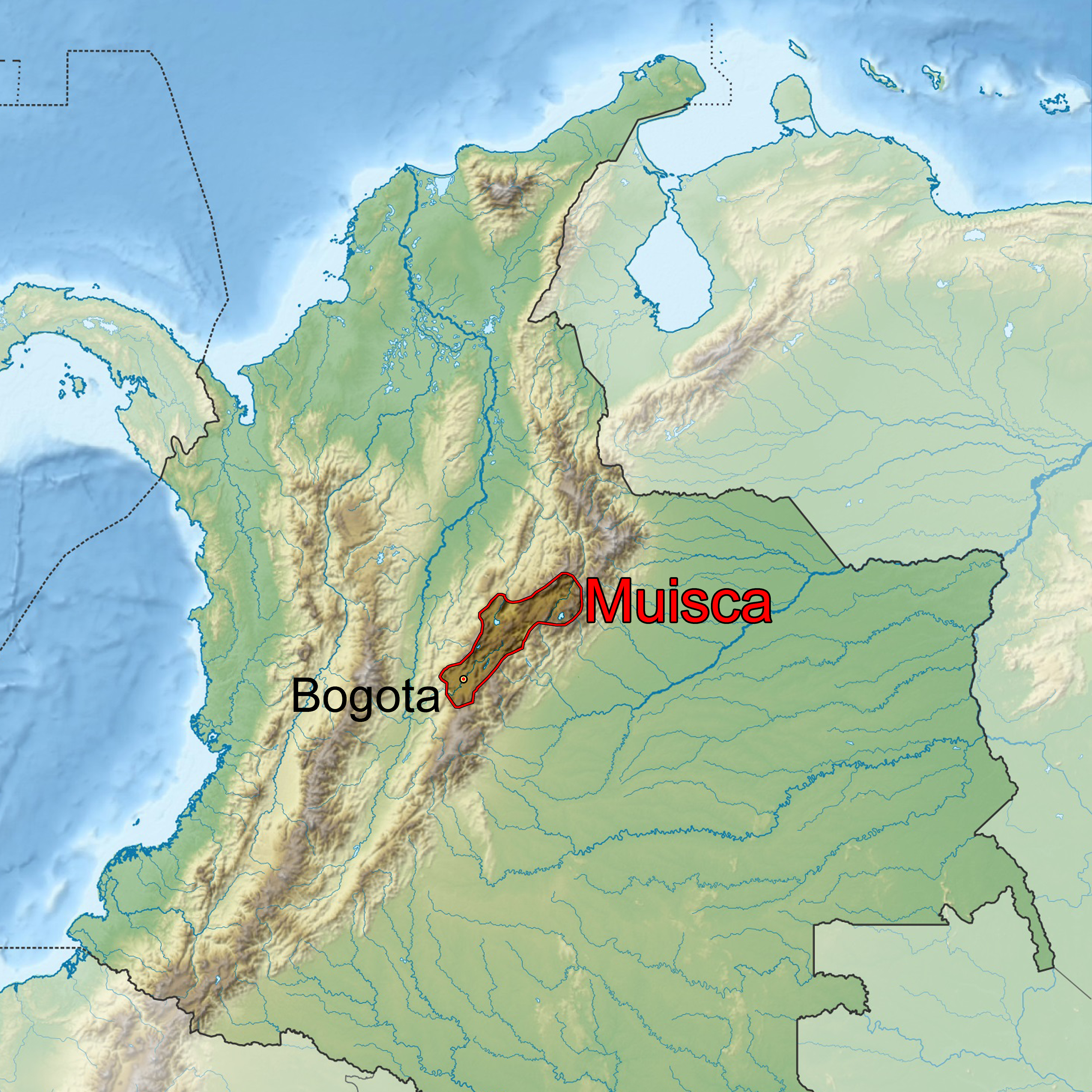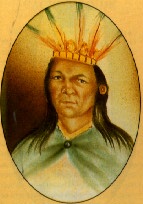|
Iraca
The ''iraca'', sometimes spelled ''iraka'',Ocampo López, 2013, Ch.12, p.77Ocampo López, 2013, Ch.14, p.85 was the ruler and high priest of Sugamuxi in the confederation of the Muisca who inhabited the Altiplano Cundiboyacense; the central highlands of the Colombian Andes. ''Iraca'' can also refer to the Iraka Valley over which they ruled. Important scholars who wrote about the ''iraca'' were Lucas Fernández de Piedrahita, Alexander von Humboldt and Ezequiel Uricoechea. Background In the centuries before the Spanish conquistadores entered central Colombia in the 1530s, the valleys of the Eastern Ranges were ruled by four main leaders and several independent ''caciques''. The northern territories were ruled by the ''zaque'' from Hunza, the present-day capital of Boyacá department and the southern area under the reign of the ''zipa'', based in Bacatá, currently known as the Colombian capital Bogotá. Other important rulers were the ''iraca'' and the ''cacique'' Tundama ... [...More Info...] [...Related Items...] OR: [Wikipedia] [Google] [Baidu] |
Altiplano Cundiboyacense
The Altiplano Cundiboyacense () is a high plateau located in the Eastern Cordillera of the Colombian Andes covering parts of the departments of Cundinamarca and Boyacá. The altiplano corresponds to the ancient territory of the Muisca. The Altiplano Cundiboyacense comprises three distinctive flat regions; the Bogotá savanna, the valleys of Ubaté and Chiquinquirá, and the valleys of Duitama and Sogamoso. The average altitude of the altiplano is about above sea level but ranges from roughly to . Etymology ''Altiplano'' in Spanish means "high plain" or "high plateau", the second part is a combination of the departments Cundinamarca and Boyacá. Geography The limits of the Altiplano are not strictly defined. The high plateau is enclosed by the higher mountains of the Eastern Ranges, with the Sumapaz mountains in the south and Chingaza to the east. The Tenza Valley is located to the east of the Altiplano and the Ocetá Páramo and Chicamocha Canyon are situated to the ... [...More Info...] [...Related Items...] OR: [Wikipedia] [Google] [Baidu] |
Firavitoba
Firavitoba is a town and municipality in Sugamuxi Province, a subregion of the department of Boyacá in Colombia. Before Spanish colonization, Firavitoba was part of the Muisca Confederation of the Chibcha people in the highlands of the Cordillera Oriental (Colombia), Eastern Cordillera of the Andean natural region, Colombian Andes. Firavitoba belonged to the Iraca or Suamox state which, uniquely, did not observe a hereditary leadership system but elected its ruler alternately from Firavitoba and Tobasá, two of its many tribes. Firavitoba is distinguished by its Gothic Revival architecture, neo-Gothic church, the third biggest in Colombia. Nuestra Señora de las Nieves (Our Lady of the Snows) was built between 1873 and 1976, entirely of stone sourced from nearby Sogamoso's Pedregal district. Etymology The name Firavitoba derives from the Muysccubun language of the Muisca people. One etymology gives the root words as ''fiba'' ("air"), and ''faoa'' ("clouds"). Geography Fir ... [...More Info...] [...Related Items...] OR: [Wikipedia] [Google] [Baidu] |
Tundama
Tundama or Saymoso (15th century - Duitama, late December 1539) was a ''cacique'' of the Muisca Confederation, a loose confederation of different rulers of the Muisca who inhabited the central highlands (Altiplano Cundiboyacense) of the Colombian Andes. The city of Tundama, currently known as Duitama and part of the Tundama Province, Boyacá, were named after the ''cacique''. Tundama ruled over the northernmost territories of the Muisca, submitted last by the Spanish conquistadores. Tundama was killed late December 1539 with a large hammer by Spanish conquistador Baltasar Maldonado. His successor, ''Don Juan'' was killed shortly after, ending the reign of the Muisca in the New Kingdom of Granada, the name for present-day Colombia and a part of Venezuela in the Spanish Empire. Knowledge about Tundama has been compiled by scholar Lucas Fernández de Piedrahita. Background In the time before the Spanish conquest of central Colombia, there were several main rulers and several ... [...More Info...] [...Related Items...] OR: [Wikipedia] [Google] [Baidu] |
Duitama
Duitama () is a city and municipality in the department of Boyacá. It is the capital of the Tundama Province. Duitama is located northeast of Bogotá, the capital city of Colombia and northeast of Tunja, the capital Boyacá. Duitama has existed since pre-Columbian times, when the Muisca inhabited the hills surrounding a former lake in the valley. The original name of Duitama was "Tundama", named after '' cacique'' Tundama. The elevation of the city is about above sea level and the average temperature is 16 °C. Duitama is known as "The Pearl of Boyacá". Etymology The name of Duitama means "to me the tribute" in muyskkubun (Muisca language). In its beginnings, Duitama corresponded to a Muisca village ruled by the cacique Tundama, a word that changed for Duitama, absolute and powerful lord that he had as bosses tributaries to the Onzaga, Soatá, Chitagoto, Susacón or Cabita, Icabuco, Lupachoque, Sátiva, Tutazá and Cerinza caciques. The natives lived in bohíos, lo ... [...More Info...] [...Related Items...] OR: [Wikipedia] [Google] [Baidu] |
Sogamoso
Sogamoso () is a city in the department of Boyacá of Colombia. It is the capital of the Sugamuxi Province, named after the original Sugamuxi. Sogamoso is nicknamed "City of the Sun", based on the original Muisca tradition of pilgrimage and adoring their Sun god Sué at the Sun Temple. The city is located at an altitude of on the Altiplano Cundiboyacense in the Eastern Ranges of the Colombian Andes. Etymology Sogamoso is named after Sugamuxi or Suamox, the original name in Chibcha for the city and Sugamuxi, the last '' iraca'' of the sacred City of the Sun. Suamuxi means "Dwelling of the Sun".Etymology Sogamoso - Excelsio.net Knowledge about Sugamuxi has been provided by Pedro Simón and the German countess [...More Info...] [...Related Items...] OR: [Wikipedia] [Google] [Baidu] |
Muisca People
The Muisca (also called Chibcha) are an indigenous people and culture of the Altiplano Cundiboyacense, Colombia, that formed the Muisca Confederation before the Spanish conquest. The people spoke Muysccubun, a language of the Chibchan language family, also called ''Muysca'' and ''Mosca''. They were encountered by conquistadors dispatched by the Spanish Empire in 1537 at the time of the conquest. Subgroupings of the Muisca were mostly identified by their allegiances to three great rulers: the '' hoa'', centered in Hunza, ruling a territory roughly covering modern southern and northeastern Boyacá and southern Santander; the '' psihipqua'', centered in Muyquytá and encompassing most of modern Cundinamarca, the western Llanos; and the ''iraca'', religious ruler of Suamox and modern northeastern Boyacá and southwestern Santander. The territory of the Muisca spanned an area of around from the north of Boyacá to the Sumapaz Páramo and from the summits to the western p ... [...More Info...] [...Related Items...] OR: [Wikipedia] [Google] [Baidu] |
Sugamuxi
Sugamuxi (died 1539) was the last ''iraca''; ''cacique'' of the sacred City of the Sun Sogamoso, Suamox. Sugamuxi, presently called Sogamoso, was an important city in the Muisca religion, religion of the Muisca people, Muisca who inhabited the Altiplano Cundiboyacense in the times before the Spanish conquest of the Muisca, Spanish conquistadors reached the central highlands of the Colombian Andes. Fellow Muisca rulers of other territories within the Muisca Confederation were Tundama in Duitama, Tundama, ''zaque'' Aquiminzaque in Tunja, Hunza and ''zipa'' Sagipa in Bogotá, Bacatá. Biography Sugamuxi was the successor of Nompanim, as ''cacique'' of Suamox. After the bloody confrontation of the ''zaque'' Quemuenchatocha and ''zipa'' Nemequene, Sugamuxi decided to stay neutral and in favour of peace between the two ever battling parts of the Muisca Confederation. [...More Info...] [...Related Items...] OR: [Wikipedia] [Google] [Baidu] |
Tunja
Tunja () is a city on the Eastern Ranges of the Colombian Andes, in the region known as the Altiplano Cundiboyacense, 130 km northeast of Bogotá. In 2018 it had a population of 172,548 inhabitants. It is the capital of Boyacá department and the Central Boyacá Province. Tunja is an important educational centre of well-known universities. In the time before the Spanish conquest of the Muisca, there was an indigenous settlement, called Hunza, seat of the ''hoa'' Eucaneme, conquered by the Spanish conquistadors on August 20, 1537. The Spanish city was founded by captain Gonzalo Suárez Rendón on August 6, 1539, exactly one year after the capital Santafé de Bogotá. The city hosts the most remaining Muisca architecture: Hunzahúa Well, Goranchacha Temple and Cojines del Zaque. Tunja is a tourist destination, especially for religious colonial architecture, with the Casa Fundador Gonzalo Suárez Rendón as oldest remnant. In addition to its religious and historical sites it ... [...More Info...] [...Related Items...] OR: [Wikipedia] [Google] [Baidu] |
Muisca Confederation
The Muisca Confederation was a loose confederation of different Muisca rulers (''zaques'', ''zipas'', '' iraca'', and ''tundama'') in the central Andean highlands of present-day Colombia before the Spanish conquest of northern South America. The area, presently called Altiplano Cundiboyacense, comprised the current departments of Boyacá, Cundinamarca and minor parts of Santander. According to some Muisca scholars the Muisca Confederation was one of the best-organized confederations of tribes on the South American continent. Modern anthropologists, such as Jorge Gamboa Mendoza, attribute the present-day knowledge about the confederation and its organization more to a reflection by Spanish chroniclers who predominantly wrote about it a century or more after the Muisca were conquered and proposed the idea of a loose collection of different people with slightly different languages and backgrounds.Gamboa Mendoza, 2016 Geography Climate Muisca Confederation In the time ... [...More Info...] [...Related Items...] OR: [Wikipedia] [Google] [Baidu] |
Iza, Boyacá
Iza is a town and municipality in Boyacá Department, Colombia. Iza is located near the Tota Lake and part of the Sugamuxi Province, a subregion of Boyacá. Iza is located in the Eastern Ranges of the Colombian Andes on the Altiplano Cundiboyacense at a distance of from Sogamoso and from the department capital Tunja. The municipality borders Firavitoba and Sogamoso in the north, Sogamoso and Cuítiva in the east, in the west Pesca and Firavitoba, and in the south Cuítiva. History Before the Spanish conquest, the area of Iza was inhabited first by indigenous groups during the Herrera Period and later by the Muisca, organized in the Muisca Confederation. Iza was ruled by the '' iraca'' of Sugamuxi, modern neighbouring Sogamoso. According to Muisca mythology, the messenger god Bochica is said to have lived outside Iza in a cave. In the Chibcha language of the Muisca ''za'' means "night", and ''Iza'' means "place of healing". [...More Info...] [...Related Items...] OR: [Wikipedia] [Google] [Baidu] |
Pesca
Pesca is a town and municipality in the Colombian Department of Boyacá, part of the Sugamuxi Province, a subregion of Boyacá. The town is located in the Eastern Ranges of the Colombian Andes at altitudes between and . Pesca is west from the department capital Tunja and borders Firavitoba in the north, Iza in the northeast, Tuta in the northwest, in the east Tota, Zetaquirá in the south, Rondón and Siachoque in the southwest and Toca in the west. Notes Pesca is east from the department capital Tunja Etymology In the Chibcha language of the Muisca, Pesca means "strong enclosure". History Before the arrival of the Spanish in the 1530s, Pesca was part of the Muisca Confederation, a confederation of different rulers; ''zaques'' based in Hunza, ''zipas'' ruling from Muyquytá and '' caciques'' in other territories. Pesca was reigned by the ''iraca'' of sacred City of the Sun Sugamuxi, now called Sogamoso. Modern Pesca was founded by Juan de Sanct Martín on ... [...More Info...] [...Related Items...] OR: [Wikipedia] [Google] [Baidu] |
Departments Of Colombia
Colombia is a unitary state, unitary republic made up of thirty-two departments (Spanish language, Spanish: ''departamentos'', sing. ''departamento'') and a Capital District (''Capital districts and territories, Distrito Capital''). Each department has a governor (''gobernador'') and an Assembly (''Asamblea Departamental''), elected by popular vote for a four-year period. The governor cannot be re-elected in consecutive periods. Departments are administrative division, country subdivisions and are granted a certain degree of autonomy. Departments are formed by a grouping of municipalities of Colombia, municipalities (''municipios'', sing. ''municipio''). Municipal government is headed by mayor (''alcalde'') and administered by a municipal council (''concejo municipal''), both of which are elected for four-year periods. Some departments have subdivisions above the level of municipalities, commonly known as provinces of Colombia, provinces. Chart of departments Each one of th ... [...More Info...] [...Related Items...] OR: [Wikipedia] [Google] [Baidu] |
.png)





